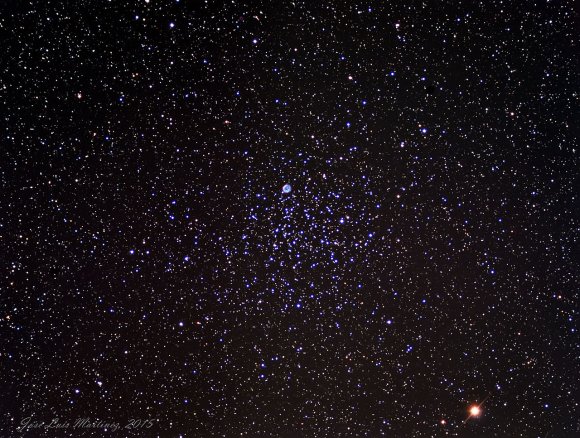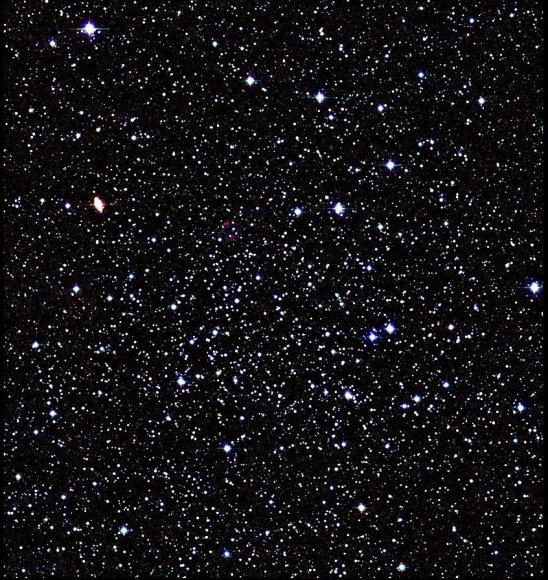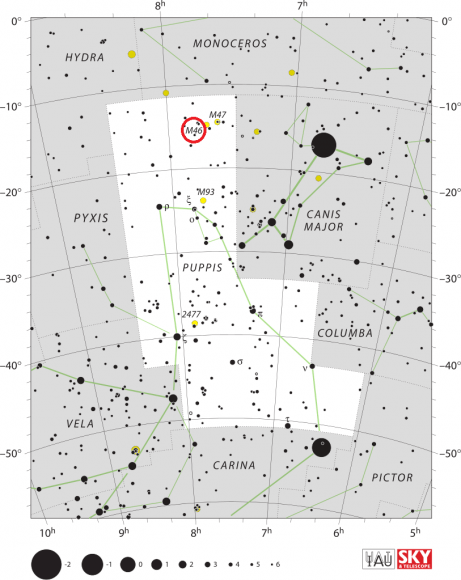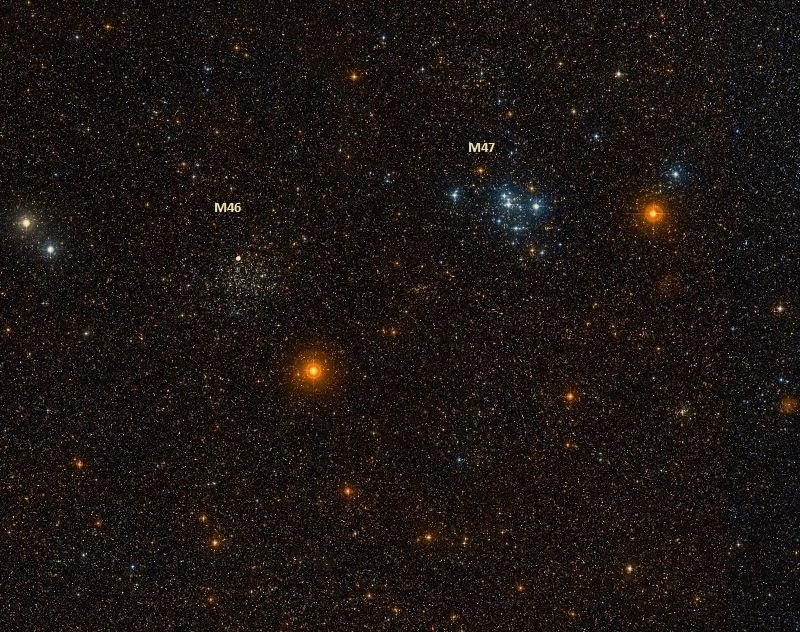During the 18th century, famed French astronomer Charles Messier noted the presence of several “nebulous objects” in the night sky. Having originally mistaken them for comets, he began compiling a list of them so that others would not make the same mistake he did. In time, this list (known as the Messier Catalog) would come to include 100 of the most fabulous objects in the night sky.
One of these objects is the open star cluster known as Messier 46, which is located about 5,500 light years away in the southern Puppis constellation. Located in close proximity to another open cluster (Messier 47), this bright, rich cluster is about 300 million years old and is home to many stars – an estimated 500 – and some impressive nebulae too.
Description:
Crammed into about 30 light years of space, around 150 resolvable stars and up to 500 possible stellar members all took off together on a journey through space some 300 million years ago. At this point in time, they are about 5,400 light years away from our solar system, but they aren’t standing still. They’re pulling away from us at a speed of 41.4 kilometers per second.

If you notice something just a bit different about one of the stars along the northern edge – then you’ve caught on to one of the most famous features of Messier 46 – its resident planetary nebula. While radial velocities show it probably isn’t a true member of the cluster, it’s still a cool feature!
But, is there more to this cluster than that? You bet. Messier 46 has also been highly studied for its core properties. As Saurabh Sharma (et al) indicated in a 2006 study:
“The study of Galactic open clusters is of great interest in several astrophysical aspects. Young open clusters provide information about current star formation processes and are key objects for clarifying questions of Galactic structure, while observations of old and intermediate-age open clusters play an important role in studying the theories of stellar and Galactic evolution. A detailed analysis of the structure of coronae of open clusters is needed to understand the effects of external environments, like the Galactic tidal field and impulsive encounters with interstellar clouds, etc., on dynamical evolution of open clusters. Extensive studies of the coronal regions of clusters have not been carried out so far mainly because of unavailability of photometry in a large field around open star clusters. The ability to obtain improved photometry of thousands of stars means that large-scale studies of open clusters can be conducted to study the spatial structure and stability of Galactic open clusters. With the addition of photometry of a nearby field region it is possible to construct luminosity functions (LFs) and MFs, which are useful for understanding cluster-formation processes and the theory of star formation in open clusters.”
History of Observation:
Messier 46 is an original discovery of Charles Messier, caught on February 19, 1771, just after he released his first catalog of entries. In his journal, he wrote:
“A cluster of very small stars, between the head of the Great Dog and the two hind feet of the Unicorn, [its position] determined by comparing this cluster with the star 2 Navis, of 6th-magnitude, according to Flamsteed; one cannot see these stars but with a good refractor; the cluster contains a bit of nebulosity.”

At the time of its discovery, Messier had not published his findings quite as immediately as we do today, so another astronomer also independently discovered this cluster as well… Caroline Herschel. “March 4th, [17]83. 1 deg S following the nebula near the 2nd Navis… a Nebula the figure is done by memory. My Brother observed it with 227 and found it to be, an astonishing number of stars. it is not in Mess. catalogue.”
It would be John Herschel in 1833 who would discover the planetary nebula while cataloging it: “The brightest part of a very fine rich cluster; stars of 10th magnitude; which fills the field. Within the cluster at its northern edge is a fine planetary nebula.”
But, as always, Admiral Symth has a way with words and observations. As he wrote of the object:
“A very delicate double star in a fine cluster, outlying the Galaxy, over Argo’s poop. A 8 1/2 [mag], and B 11, both pale white.A noble though rather loose assemblage of stars from the 8th to the 13th magnitude, more than filling the field, especially in length, with power 93; the most compressed part trending sf [south following, SE] and np [north preceding, NW]. Among the larger [brighter] stars on the northern verge is an extremely faint planetary nebula, which is 39 H. IV. [NGC 2438], and 464 of his son’s Catalogue. This was discovered by Messier in 1769, who considered it as being “rather enveloped in nebulous matter;” this opinion, however, must have arisen from the splendid glow of mass, for judging from his own remark, it is not likely that he perceived the planetary nebula on the north. WH [William Herschel], who observed it in 1786, expressly says, “no connexion with the cluster, which is free from nebulosity.” Such is my own view of attentively gazing; but the impression left on the senses, is that of awful vastness and bewildering distance, – yet including the opinion, that those bodies bespangled the vastness of space, may differ in magnitude and other attributes.”
Pretty amazing considering these gentlemen did all of their observations visually and knew nothing about today’s parallaxes, radial velocities or any other type of thing. May your own observations be as talented…
Locating Messier 46:
There is no simple way of finding Messier 46 in the finderscope of a telescope, but it’s not too hard with binoculars. Begin your hunt a little more than a fistwidth east/northeast of bright Sirius (Alpha Canis Majoris)… or about 5 degrees (3 finger widths) south of Alpha Monoceros. There you will find two open clusters that will usually appear in the same average binocular field of view. M46 is the easternmost of the pair.

It will appear slightly dimmer and the stars will be more concentrated. In the finderscope it will appear as a slightly foggy patch, while neighboring western M47 will try to begin resolution. Because M46’s stars are fainter, it is better suited to darker sky conditions, showing as a compression in binoculars and will resolve fairly well with even a small telescope. However, you will need at least a 6″ telescope to perceive the planetary nebula.
And here are the quick facts on this Messier Object to help you get started:
Object Name: Messier 46
Alternative Designations: M46, NGC 2437
Object Type: Open Galactic Star Cluster
Constellation: Puppis
Right Ascension: 07 : 41.8 (h:m)
Declination: -14 : 49 (deg:m)
Distance: 5.4 (kly)
Visual Brightness: 6.0 (mag)
Apparent Dimension: 27.0 (arc min)
We have written many interesting articles about Messier Objects here at Universe Today. Here’s Tammy Plotner’s Introduction to the Messier Objects, , M1 – The Crab Nebula, M8 – The Lagoon Nebula, and David Dickison’s articles on the 2013 and 2014 Messier Marathons.
Be to sure to check out our complete Messier Catalog. And for more information, check out the SEDS Messier Database.
Sources:

